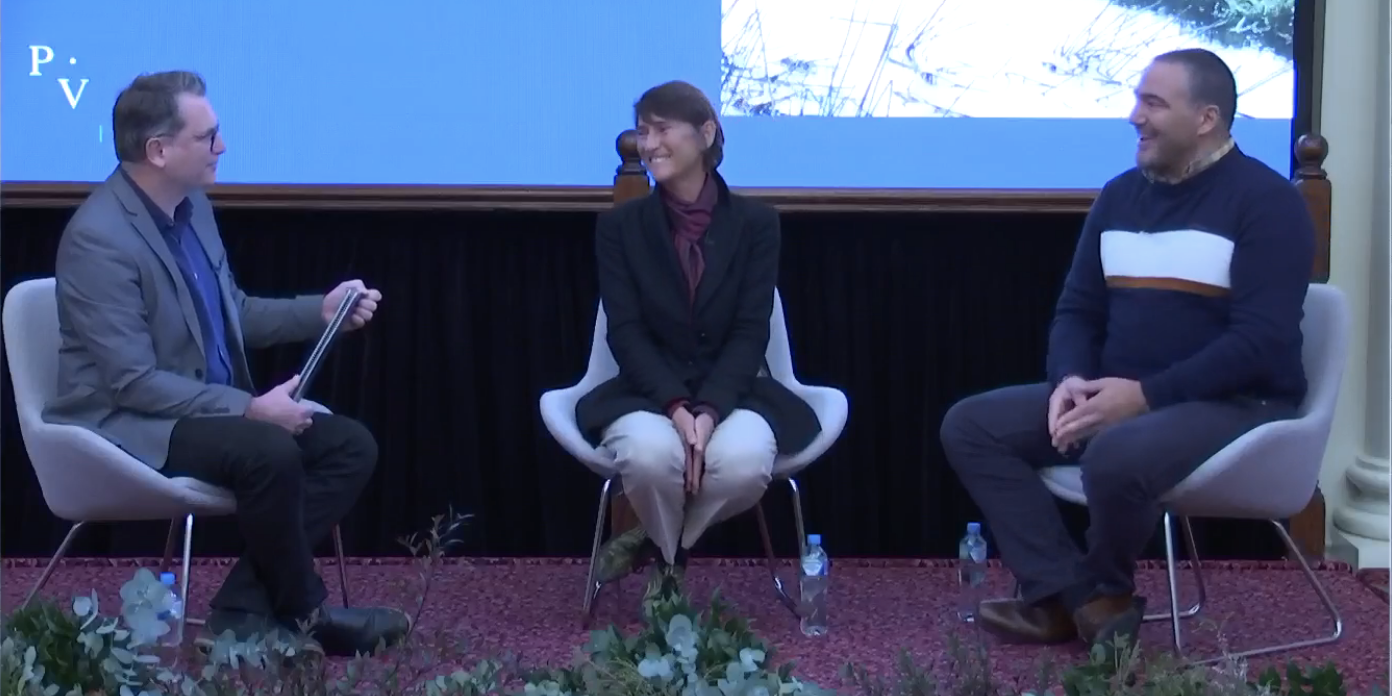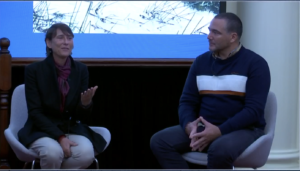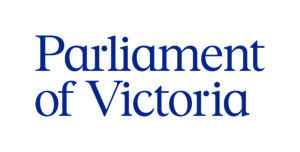Science on Country

by Dr Catriona Nguyen-Robertson
This article follows a panel discussion during NAIDOC Week 2022 with two Wiradjuri scholars – Associate Professor Michael-Shawn Fletcher and Kate Harriden – for a conversation about the exciting opportunities that Aboriginal knowledge offers for urban and regional environmental management.
Yindyamarra. It is a Wiradjuri word that is often translated as ‘respect’. However, the word has many meanings: gentleness, to honour, go slow, and take responsibility. It describes a way of living.
And it is how we should treat Indigenous Knowledge.
The tradition that we call “Western science” is barely 400 years old. Yet, across Australia, rich cultural knowledge traditions and practices have been passed down over tens of thousands of years by First Peoples.
When it comes down to it, what is science? Is it not merely a tool with which we observe the world around us and to pursue knowledge and learn to make predictions?
Cultures around the world have developed different views of nature throughout human history. First Peoples across the globe use observations to understand, interpret, and interact with their environment. Throughout history, they have created remarkable feats of engineering, developed tools, and learned to manage and use resources in their environment that ensures their conservation into the future. Their wealth of wisdom and experience of nature acquired over generations is rooted in their traditions and knowledge systems.
Western science and Indigenous Knowledge do not have to be separate. They each hold great value and are beginning to find a path to each other. Two Wiradjuri people, Associate Professor Michael-Shawn Fletcher and Kate Harriden are at the intersection of their traditional knowledge and academia. They believe that Indigenous Knowledge offers many benefits in urban and regional environmental management – only so long as it is treated with the respect it deserves.
The Disruption of Indigenous Knowledge
Indigenous Knowledge held by Aboriginal and Torres Strait Islander peoples has been built on careful observation over 65,000 years. But their rich history, knowledge, and traditions were disrupted. European principles of land, water and ecological management were forced upon this continent after invasion, leading to overwhelmingly poor ecological outcomes.
The dispossession of First Peoples has had a deep social and ecological impact. This includes neglect of entire ecosystems – the direct result of denying First Nations Australians the right to exercise their duty of care over Country. “Biodiversity loss and catastrophic fires: they began immediately after the invasion by the British into the Australian continent and the removal of Aboriginal burning,” Michael-Shawn says.
By studying charcoal and pollen in natural archives (e.g. in lake sediments and ice cores that hold the history of the land), Michael-Shawn learns about changes in the environment. His work demonstrates that the most drastic change in environment on this continent since the Ice Age 12,000 years ago was British invasion.
For millennia, land-use and cultural practices of First Nations Australians shaped the environment. In turn, their environment heavily influences traditional ways of life. Their landscape management creates a predictable, bountiful, safe environment. It fosters nature’s ability to provide resources and to provide a secure place to live. This is scientific knowledge, accumulated by more than 3,000 generations of people who have passed on how to live on Country based on observation.
It does not make sense to shoehorn European ideas onto this land. Melbourne is notorious for its “four seasons in one day” and unpredictable weather. We also sometimes comment on the weather being “too warm” for winter or “too cold” for summer. But this is because people generally measure the weather against the norms of traditional European seasons from the other side of the globe.
Kate and Michael-Shawn argue that Indigenous weather calendars should be adopted as they are guided by observations of environment on Country. Careful observations and local knowledge of one area make environmental changes in that place a little more predictable.
One example of where a human-centric control of the landscape has suffocated Country is water management. As an academic, Kate is trying to find ways to incorporate Indigenous science practices into urban water management. We can learn from Indigenous practices to observe our water bodies over a long period of time rather than popping in to report every few years, and to work collaboratively in a whole community effort.
‘We can’t keep having stormwater channels function the way they do,’ Kate says. ‘They just flush dirty water out to some other place. It’s all wasted water and you can’t recycle the nutrients; you’re just moving a pollutant from one area and over-polluting another.’ She has particularly seen how dedicated infrastructure has resulted in clean water in an artificial pond and only 500 metres downstream the water was putrefied.
Michael-Shawn sees the same in his work in fire management. The dominant narrative of Western society is that fire is an agent of suppression. There were no large fires in Gippsland for 1500 years but now, the fires are uncontrolled, destructive, and catastrophic. The Gunaikurnai people, the Traditional Custodians of Country covering much of Gippsland, used fire to reduce fuel loads and support flourishing biodiversity. Now there is a desire to see Mob managing Country, and Michael-Shawn hopes that, with time and yindyamarra, the land will bounce back.
First Nations peoples have been actively creating, managing, and maintaining nature in Australia for tens of thousands of years. Now Australia faces a biodiversity crisis and we are looking for solutions. Integral to any solution needs Indigenous Knowledge and land management practices.
Working with Mob
Conservation efforts are critical right now. But can we rely on Western science alone to put things right when it created the problem in the first place? Kate and Michael-Shawn think not.
Western science has a history of excluding and exploiting First Nations people, which stems from the devaluing of Indigenous knowledge. It is still regarded as myth, legend and fable, and not seen as thousands of years’ worth of observations – even though Western science is also built on observation.
Yet the evidence that traditional knowledge holds so much value is there. Mob has generations-worth of knowledge on the behaviour and location of native animals and therefore conservation efforts are intrinsically more successful with their help. For example, an initial release of captive-bred critically endangered regent honeyeater into the wild failed, but in another attempt, they were released on Wonnarua Country with guidance from the Mindaribba Local Aboriginal Land Council – this next time, they survived.
Many Western ecologists and environmental scientists rely on First Peoples to guide their work: helping them to find wildlife, to navigate rugged terrain or to understand changing weather trends. But these relationships have often felt colonial, extractive and unequal. “Science” has not always been a friend to First Peoples, with many atrocities having been performed in the name of science.
While it is important that Western scientists listen to Mob, they need to tread lightly. Traditional knowledge, while an incredibly valuable source of information, has been dismissed for so long by so many.
Even now, researchers drop into communities, gather data and leave — never contacting the Traditional landowners and local communities again, and selectively taking data sets that suit their purpose or excluding them from the publication process.

Kate and Michael-Shawn encourage researchers to instead go by yindyamarra. If Western scientists who do field work on Country invest time to have conversations with Mob, then we might have a chance of restoring the relationship, and subsequently, nature, culture, and communities. Michael-Shawn even suggested that Traditional Knowledge holders should be invited in scientific discussions as part of grant applications rather than only being contacted once funding has been secured and their knowledge is deemed needed. We all have to work together respectfully, or else we can never achieve the best research for Country and people.
First Nations peoples do not need Western scientists to validate or legitimate their knowledge systems. But their knowledge does need to be treated with respect. It is encouraging to see that more partnerships are developing worldwide with Indigenous knowledge holders and Western scientists working side-by-side.
Western science and traditional knowledge constitute different paths to knowledge, but they are rooted in the same reality, and really, Western science is only just catching up after several thousand years.
‘We’re always on Country. We’re on Country right now…but you have to actively engage,’ says Michael-Shawn.
 The STEM and Society series of panel discussions highlights the game-changing work undertaken by Victorian scientists, researchers and other holders of specialised knowledge. In 2022, the series had a particular focus on biodiversity conservation and recovery, with Bill Bainbridge facilitating discussions with leaders in this area to share their perspectives on protecting Victoria’s biodiversity. Presented as a partnership between the Parliament of Victoria, the Royal Society of Victoria, and the Victorian Parliamentarians for STEM as a part of the Inspiring Victoria program, discussions were held in the chambers at Parliament House, where Victorian era grandeur added gravitas to conversations. “Science on Country” was convened in partnership with the Indigenous Knowledge Institute at the University of Melbourne. Proceedings were broadcast to a live audience; the recording is provided below.
The STEM and Society series of panel discussions highlights the game-changing work undertaken by Victorian scientists, researchers and other holders of specialised knowledge. In 2022, the series had a particular focus on biodiversity conservation and recovery, with Bill Bainbridge facilitating discussions with leaders in this area to share their perspectives on protecting Victoria’s biodiversity. Presented as a partnership between the Parliament of Victoria, the Royal Society of Victoria, and the Victorian Parliamentarians for STEM as a part of the Inspiring Victoria program, discussions were held in the chambers at Parliament House, where Victorian era grandeur added gravitas to conversations. “Science on Country” was convened in partnership with the Indigenous Knowledge Institute at the University of Melbourne. Proceedings were broadcast to a live audience; the recording is provided below.
